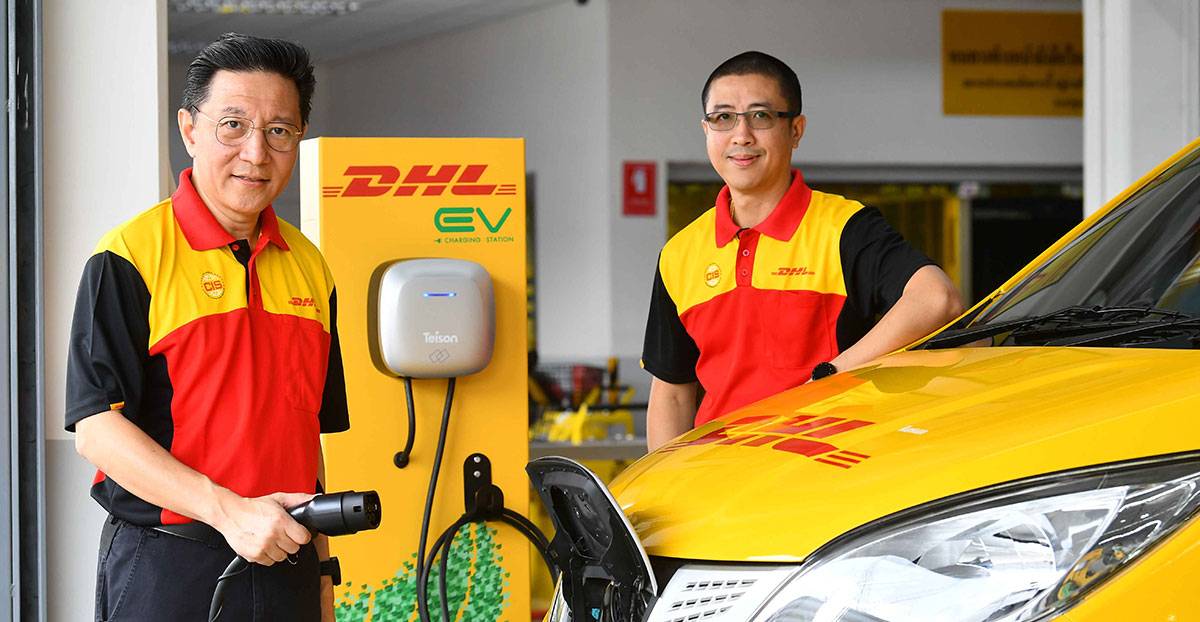- 16 electric vans to be deployed in Bangkok for first-and-last-mile deliveries
- By 2023, DHL will have 71 electric vehicles serving Thailand
- DHL Express is committed to electrify 60% of its fleet globally by 2030
DHL Express, the world’s leading international express service provider, has expanded its fleet of electric vehicles (EVs) in Thailand with an additional 16 electric vans for first-and-last-mile deliveries. This is on top of the 50 electric motorbikes that are currently serving customers. The expansion marks the company as the first logistics provider in the country to transition to a commercial EV fleet.
These electric vans are deployed to deliver shipments in early March, serving Bangkok’s Sathorn, Silom, Pathumwan, Rama III, Rama IV, Sukhumvit Road and New Petchaburi Road. DHL Express will further add five vans at a later phase to cover routes in Thailand’s eastern cities to bring the total number of its EV fleet to 71 by 2023. The company plans to electrify 60% of vehicles in Thailand by 2030.
Herbert Vongpusanachai, Managing Director, DHL Express Thailand and Head of Indochina, said, “Sustainability is not a trend but a mission that we’re prioritizing and aiming to achieve through our solid action plan. As a global leader in the logistics industry, we must influence the industry to minimize carbon footprint across logistics operations. We are on the way to achieving net-zero emissions by 2050 with a focus on green logistics. By transitioning to EVs, DHL Express Thailand is set to reduce a total of 436 tonnes of CO2 emissions yearly. This new batch of EVs is a milestone in our journey toward sustainable logistics and an inclusive future for all.”

The new electric vans require eight hours to be fully charged for a travel distance up to 260 kilometers, carrying up to 3.9 cubic meters or 1.6 tons of load. Each EV is expected to run 3,000 kilometers per month. Anti-braking system (ABS), automatic lock, sensor alarm and electronic brakeforce distribution (EBD) are among the standard features that ensure the safety of couriers.
The slam lock is a supplementary safety feature that automatically locks all doors when a courier shuts one of them, providing additional protection when leaving the vehicle for delivery. The telematics system installed in each vehicle captures data from front, interior, and rear cameras, allowing for real-time monitoring and safety alerts on the driver and the vehicle.
“This is another huge step in our decarbonization journey and a move forward to making green logistics and sustainability more meaningful,” added Siwawate Hongnakorn, Vice President of Operations, DHL Express Thailand. “At the end of this year, we will be able to electrify 29 percent of our last-mile delivery vehicles. We will continue our efforts as a pioneer in the market to reduce our carbon emissions for climate protection.”
With the deployment of electric vehicles, DHL will see a total reduction of 436 tonnes of CO2 emissions yearly. DHL has been developing its infrastructure to support EV deployment, including adding smart charging points at the service centers to cater to even more additional electric vans this year.
This initiative forms part of Deutsche Post DHL Group’s global target to electrify 60 percent of its last-mile delivery vehicles by 2030. Apart from fleet electrification, the Group’s strategy on clean operations for climate protection includes targeting more than 30 percent Sustainable Aviation Fuels blending by 2030, carbon neutral design for all new buildings and offering green products, such as the recently-launched GoGreen Plus service to help customers reduce GHG emissions.
In line with its Sustainability Roadmap, DPDHL Group will invest a total of EUR 7 billion until 2030 in CO2 reduction measures. This includes the expansion of its e-vehicle fleet. DHL Express plans to have more than 1,000 electric vehicles in Asia Pacific by 2024.
The expansion to electric vans is also aligned with the National 30@30 Policy, which aims to make 30% of vehicles in Thailand zero-emission vehicles (ZEV) by 2030, as Thailand commits to moving into a low-carbon society. The country also plans to become the manufacturing hub of electric vehicles and auto parts in ASEAN.
- รถขนส่งพลังงานไฟฟ้า 16 คันถูกนำมาใช้สำหรับการขนส่งลาสไมล์ในกรุงเทพฯ
- ภายในปี 2566 ดีเอชแอลจะมีรถขนส่งพลังงานไฟฟ้า 71 คันให้บริการในประเทศไทย
- ดีเอชแอล เอ๊กซ์เพรส ตั้งเป้าการใช้รถขนส่งไฟฟ้า 60% สำหรับการขนส่งสินค้าทั่วโลกภายในปี 2573
ดีเอชแอล เอ๊กซ์เพรส ผู้ให้บริการขนส่งด่วนระหว่างประเทศชั้นนำของโลก ขยายจำนวนยานยนต์ไฟฟ้า (EV) ที่ใช้ในการขนส่งในประเทศไทย โดยเพิ่มรถขนส่งพลังงานไฟฟ้าอีก 16 คัน ในการจัดส่งแบบลาสไมล์ นอกเหนือจากรถมอเตอร์ไซค์ไฟฟ้า 50 คันที่ใช้งานอยู่ในปัจจุบัน การขยายจำนวนการใช้งานรถ EV ในครั้งนี้ทำให้ดีเอชแอล เอ๊กซ์เพรส เป็นผู้ให้บริการลอจิสติกส์รายแรกในประเทศไทยที่เปลี่ยนไปใช้รถ EV ในเชิงพาณิชย์อย่างเต็มรูปแบบ
รถขนส่งพลังงานไฟฟ้านี้เริ่มทำการขนส่งสินค้าในช่วงต้นเดือนมีนาคม 2566 โดยให้บริการในกรุงเทพฯ เขตพื้นที่ต่างๆ ได้แก่ สาทร, สีลม, ปทุมวัน, พระราม 3, ถนนสุขุมวิท, และถนนเพชรบุรีตัดใหม่ โดยดีเอชแอลมีแผนที่จะเพิ่มรถขนส่งพลังงานไฟฟ้าอีก 5 คันในเฟสถัดไป เพื่อใช้งานในเส้นทางภาคตะวันออก ซึ่งจะทำให้ดีเอชแอลมีรถ EV ที่ให้บริการทั้งหมดในประเทศไทยรวมจำนวน 71 คัน ภายในปี 2566 ทั้งนี้บริษัทฯ ตั้งเป้าที่จะเปลี่ยนมาใช้รถ EV เป็นจำนวน 60% ของยานพาหนะทั้งหมดในประเทศไทย ภายในปี 2573
เฮอร์เบิร์ต วงศ์ภูษณชัย กรรมการผู้จัดการ ดีเอชแอล เอ๊กซ์เพรส ประเทศไทย และหัวหน้าภาคพื้นอินโดจีน กล่าวว่า “ความยั่งยืนไม่ใช่เทรนด์ แต่เป็นภารกิจที่เราให้ความสำคัญมาเป็นอันดับหนึ่ง และดีเอชแอลมีแผนการดำเนินงานที่ชัดเจนเพื่อให้บรรลุเป้าหมายที่ตั้งไว้ ในฐานะผู้นำอุตสาหกรรมลอจิสติกส์ระดับโลก เราจำเป็นต้องผลักดันให้ทุกภาคส่วนในอุตสาหกรรมร่วมมือกันเพื่อลดการปล่อยก๊าซคาร์บอนในการดำเนินงานด้านลอจิสติกส์ และเรากำลังเดินหน้าสู่เป้าหมายลดการปล่อยก๊าซคาร์บอนสุทธิให้เหลือศูนย์ ภายในปี 2593 โดยให้ความสำคัญกับการเป็นกรีนลอจิสติกส์ ด้วยการเปลี่ยนไปใช้รถขนส่งพลังงานไฟฟ้า ดีเอชแอล เอ๊กซ์เพรส ประเทศไทย ตั้งเป้าที่จะลดการปล่อยก๊าซคาร์บอนไดออกไซด์ทั้งสิ้น 436 ตันต่อปี โดยรถขนส่งพลังงานไฟฟ้าชุดนี้นับเป็นก้าวสำคัญในการนำเราไปสู่ลอจิสติกส์ที่ยั่งยืน และการสร้างอนาคตที่เอื้อประโยชน์ให้แก่ทุกคน”

รถขนส่งพลังงานไฟฟ้ารุ่นใหม่นี้ใช้เวลา 8 ชั่วโมงในการชาร์จไฟจนเต็ม โดยจะรองรับการเดินทางได้ 260 กิโลเมตร บรรทุกของได้ถึง 3.9 ลูกบาศก์เมตร หรือ 1.6 ตัน รถแต่ละคันจะวิ่งขนส่งรวมระยะทาง 3,000 กิโลเมตรต่อเดือน โดยมีระบบเบรก ABS, ระบบล็อคอัตโนมัติ, สัญญาณเตือนโดยใช้เซ็นเซอร์, และระบบควบคุมการกระจายแรงเบรก (EBD) ซึ่งเป็นคุณสมบัติมาตรฐานที่สร้างความปลอดภัยในการขับขี่ให้กับพนักงานขนส่ง
สแลมล็อค (Slam Lock) เป็นระบบรักษาความปลอดภัยเสริม โดยจะล็อคประตูรถทุกบานโดยอัตโนมัติเมื่อผู้ขับรถปิดเพียงประตูเดียว ซึ่งจะช่วยเพิ่มความปลอดภัยเมื่อผู้ขับไม่ได้อยู่กับตัวรถ ระบบเทเลเมติกส์ที่ติดตั้งอยู่ในรถยนต์ไฟฟ้าทุกคันจะบันทึกข้อมูลจากกล้องด้านหน้า ด้านใน และด้านหลัง ทำให้สามารถตรวจสอบและแจ้งเตือนความปลอดภัยแบบเรียลไทม์เมื่อเกิดเหตุเกี่ยวกับรถและผู้ขับรถได้ทันที
ศิวเวศม์ หงษ์นคร รองประธานฝ่ายปฏิบัติการ ดีเอชแอล เอ๊กซ์เพรส ประเทศไทย กล่าวเสริมว่า “นับเป็นอีกก้าวที่สำคัญของเราในการเดินหน้าลดการปล่อยก๊าซคาร์บอน ทำให้กรีนลอจิสติกส์และอนาคตที่ยั่งยืนมีความหมายมากขึ้น ภายในปีนี้ รถขนส่งพลังงานไฟฟ้าสำหรับการขนส่งลาสไมล์ของดีเอชแอล เอ๊กซ์เพรส จะเพิ่มเป็น 29 เปอร์เซ็นต์ของจำนวนยานพาหนะทั้งหมด และเราจะยังคงมุ่งมั่นดำเนินการอย่างต่อเนื่องในฐานะผู้บุกเบิกตลาดในการลดการปล่อยก๊าซคาร์บอนไดออกไซด์ เพื่อสภาพภูมิอากาศที่ดีขึ้น”
ด้วยการใช้รถขนส่งพลังงานไฟฟ้า ดีเอชแอล เอ๊กซ์เพรส ประเทศไทย จะสามารถลดปริมาณการปล่อยก๊าซคาร์บอนไดออกไซด์ได้ 436 ตันต่อปี ดีเอชแอลได้พัฒนาโครงสร้างพื้นฐานเพื่อรองรับการใช้รถ EV รวมถึงการเพิ่มจุดชาร์จอัจฉริยะที่ศูนย์บริการเพื่อรองรับปริมาณรถ EV ที่จะเพิ่มขึ้นในปีนี้
ความริเริ่มนี้เป็นส่วนหนึ่งของเป้าหมายระดับโลกของกลุ่มบริษัทด๊อยช์โพสต์ ดีเอชแอลที่จะใช้ยานยนต์ไฟฟ้า 60% เพื่อการขนส่งลาสไมล์ภายในปี 2573 นอกจากการเปลี่ยนผ่านในการใช้รถ EV แล้ว บริษัทยังสร้างการขนส่งที่เป็นมิตรกับสิ่งแวดล้อม รวมถึงการตั้งเป้าผสมผสานการใช้เชื้อเพลิงยั่งยืนในการขนส่งด้วยเครื่องบิน (Sustainable Aviation Fuels) ให้ได้มากกว่า 30 เปอร์เซนต์ ภายในปี 2573, การออกแบบอาคารที่ลดคาร์บอน และนำเสนอผลิตภัณฑ์ที่เป็นมิตรต่อสิ่งแวดล้อม เช่น บริการ GoGreen Plus ที่ดีเอชแอลเพิ่งเปิดตัวไปเมื่อเร็วๆ นี้ เพื่อช่วยลูกค้าในการลดการปล่อยก๊าซเรือนกระจก
เพื่อให้สอดคล้องกับกลยุทธ์ด้านความยั่งยืน กลุ่มบริษัทด๊อยช์โพสต์ ดีเอชแอลจะลงทุนเป็นจำนวน 7 พันล้านยูโร ในด้านมาตรการลดการปล่อยก๊าซคาร์บอนไดออกไซด์ จนถึงปี 2566 ซึ่งรวมถึงการเพิ่มจำนวนรถ EV ทั้งนี้ ดีเอชแอล เอ๊กซ์เพรส วางแผนที่จะใช้รถ EV มากกว่า 1,000 คันในเอเชียแปซิฟิกภายในปี 2567
การขยายไปสู่การใช้รถขนส่งพลังงานไฟฟ้าในครั้งนี้ของดีเอชแอล ได้สอดคล้องกับนโยบาย 30@30 ของประเทศไทย ซึ่งมีเป้าหมายในการทำให้รถยนต์ 30% ในประเทศเป็นรถยนต์ที่ปล่อยมลพิษเป็นศูนย์ (ZEV) ภายในปี 2573 โดยประเทศไทยมุ่งมั่นที่จะพัฒนาไปสู่สังคมคาร์บอนต่ำ และตั้งเป้าเป็นศูนย์กลางการผลิตรถยนต์ไฟฟ้าและชิ้นส่วนยานยนต์ในภูมิภาคอาเซียน

